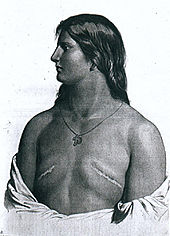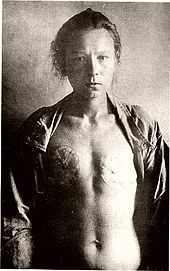Skopzen
The Scopts (singular: Skopez from Russian скопец "eunuchs, eunuch , castrato "), even white doves and white lambs ( белые голуби called) are one in Russia resulting religious sect that 1757 as a secret society from the tradition of Flagellantensekte the Chlysten came out and propagated complete sexual abstinence . The followers drove asceticism to such an extent that ritual mutilation of the external genitalia and later also of the female breast became mandatory. Despite continuous state persecution and exile to Siberia , the Scopcentum was able to spread in Russia. Many Skopzen emigrated to Romania . In the 19th century, the spiritual Skopzen , which still exist today, split off, demanding total sexual abstinence, but not practicing physical mutilation.
Teaching
All sexual intercourse was forbidden among the Skopzen. In addition, the genital mutilation made it impossible.
For justification, the Skopzen cited the Bible passages Mt 19.12 EU , Mk 9.43 EU , Mt 5.26.30 EU and Lk 23.29 EU . They believed that all calamity and evil came into the world through sexual intercourse between Adam and Eve , and the true teaching of Christ included the practice of castration . In addition, the Skopzen claimed that Jesus was the first Skopzen and had personally set the example. Thereafter, castration was also practiced by the apostles , the saints and the early Christians . The Skopzen assumed that man was endowed with genitals by the devil through original sin and the death of Abel ; they saw in it "marks of Satan".
Rituals
Devotional exercises
The religious exercises of Scopts existed in the hymn singing , impromptu -Ansprachen, prophecies and wild ritual dances that a visionary ecstasy should lead and recall dervish dances. The meetings mostly took place at night in isolated houses and lasted until dawn. During the meetings, the Skopzen posted guards around the building. The believers occasionally danced to the point of physical breakdown.
Last supper
With the Skopzen there was a kind of Holy Communion, at which consecrated pieces of bread were distributed. In order to be redeemed, according to the Skopzian doctrine of faith, according to the main commandment of Christ, man had to undergo the “baptism of fire”, during which he was castrated or his (external) genitals were mutilated with a red-hot iron.
"Baptism of fire"
The Skopzen propagated complete sexual abstinence and demanded that male members remove the testicles and penis as a condition for entry into the kingdom of heaven, and that women circumcise the vulva and remove the female breast . With the male Skopzen, when the climax of the ritual act, "the baptism of fire", was reached, there was a higher and a lower form of crossing the "gate to perfect redemption":
- the "little seal" referred to the removal of the testicles , in which the Skopzen saw the "key to hell";
- the "big seal" referred to the additional removal of the penis , which the Skopzen understood as the "key to the abyss", whereby the "abyss" meant the female genitals as an object of pleasure.
Female circumcision was carried out less frequently. From around 1815 onwards, women began to mutilate their breasts and vulva with the intention of restricting the sexual drive and restricting the possibility of coitus . These were the clitoris and the small labia removed the nipples cut or split or ablation made of the breasts. The interventions were carried out with kitchen knives, hatchets , sickles and glowing knives or by tying them with a string.
The sect members were called "donkeys" and "goats" before the ritual mutilation and then called "white doves" and "white lambs".
history
The Skopzentum emerged in the 18th century from the flagellant sect of the Chlysten . The first Scopts group was in 1757 in the Russian Oryol Governorate discovered where the Russian peasant Andrei Ivanov was transferred (1732-1832), thirteen farmers to self-mutilation to have persuaded. Ivanov has been described as fanatical and strong-willed. Originally Chlyst, he was influenced by Manichaeism and viewed any form of sexual intercourse as a sin . In order to avoid this sin in any case, he emasculated himself and thus became the founder of the Skopzen. Ivanov lived as a petty bourgeois in Saint Petersburg from 1802 and called himself "Kondratij Seliwanow" there. Selivanov claimed that with Tsar Peter III, who was murdered in 1762 . to be identical to the returned Christ and who escaped an attack by Catherine II by exchanging clothes .
The Skopzen expected the return of their founder as Messiah . They believed that he would establish his kingdom in Russia and hand over all power on earth to the "saints" and "virgins". Because, according to Revelation 7.9, it took 144,000 sexless before the Messiah appears, the Skopzen were busy propaganda for their religious community. The main centers of cult activity within Russia were Saint Petersburg , Moscow , Morschansk and Odessa . In Bucharest and Iasi , colonies formed from Russians who had fled persecution in their homeland. In 1866 there were 5,444 Skopzen, including 3,979 men and 1,465 women.
Despite the strictest security measures on the part of the Russian government, the Skopzen found ways to win members for themselves. So Selivanov succeeded in persuading both nephews of the Saint Petersburg Governor General Miloradovich to join. Until the abolition of serfdom in Russia in 1861, the Skopzen recruited new members mainly from the ranks of the serfs, for whom they bought freedom from their owners - on the condition that the freed would be castrated. The wealth of the Skopzen (they were considered to be the richest lenders in Russia at that time, not least because they often had no children of their own and did not spend money on physical pleasures) helped them to win new members. Religiously motivated mutilations of the genitals are still documented after the Second World War .
In the course of persecution, the Skopzen clergy and the Neuskopzen , who still exist today, split off from the Skopzen in the 19th century . Instead of mutilation, they only practice strict asceticism and sexual abstinence.
See also
literature
- Alexander Etkind: Chlyst. sekty, literatura i revoljucija. Moscow 1998
- Karl Konrad Grass : The secret holy scripture of the Skopzen. Leipzig 1904
- Karl Konrad Grass: history and personality of the Skopzen sect. In: MNR. Volume 63, 1910, pp. 97-114
- Karl Konrad Grass: Russian sects. Part 4: Skopzen. In: Religion Past and Present . 1st edition, Volume 5, 1913, pp. 74-90
- Karl Konrad Grass: The Russian sects. Volume 2. The white doves or Skopzen together with clergymen Skopzen, Neuskopzen and others Hinrichs, Leipzig 1914 ( digitized version )
- AI Klebanow: Is Mira Religiosnowo Sektantswa .
- Walter Koch: About the Russian-Romanian castrato sect of the Skopzen , Fischer, 1921 (examination report of a German pathologist (1880–1962))
- Ionel Rapaport : Introduction a la psychopathologie collective la secte mystique des Skoptzy. Erka, Paris 1949
- Alina Simone : I wanted unicorns . A. d. American. by Vandis Buhr. [Orig .: You must go and win, New York 2011]. Graf, Munich 2015. ISBN 978-3-86220-043-6 . (In it: The advantages of self-castration , pp. 184–221).
- F. von Stein (Gotha): The Skopzen sect in Russia in its origin, organization and teaching. Represented from the most reliable sources. In: Journal for Ethnology - Organ of the Berlin Society for Anthropology, Ethnology and Prehistory , Seventh Volume, 1875; Pp. 37-69. Scan .
- Nikolai Volkov : La secte russe des castrats . Paris 1995
- Jean D. Wilson , Claus Roehrborn: Long-Term Consequences of Castration in Men: Lessons from the Skoptzy and the Eunuchs of the Chinese and Ottoman Courts In: The Journal of Clinical Endocrinology & Metabolism , 1999, 84:12; Pp. 4324-4331. doi: 10.1210 / jcem.84.12.6206 . (English)
Web links
Individual evidence
- ↑ Marco Frenschkowski : The secret societies. A cultural and historical analysis. Marixverlag, Wiesbaden 2007, ISBN 978-3-86539-926-7 , pp. 199-200.
- ↑ a b c Karl RH Frick : Light and Darkness. Gnostic-theosophical and Masonic-occult secret societies up to the turn of the 20th century , Volume 2; Marix Verlag, Wiesbaden 2005; ISBN 3-86539-044-7 ; P. 456.
- ^ A b Karl RH Frick: Light and Darkness. Gnostic-theosophical and Masonic-occult secret societies up to the turn of the 20th century , Volume 2; Marix Verlag, Wiesbaden 2005; ISBN 3-86539-044-7 ; P. 454.
- ^ Karl RH Frick: Light and Darkness. Gnostic-theosophical and Masonic-occult secret societies up to the turn of the 20th century , Volume 2; Marix Verlag, Wiesbaden 2005; ISBN 3-86539-044-7 ; P. 455.
- ^ Karl RH Frick: Light and Darkness. Gnostic-theosophical and Masonic-occult secret societies up to the turn of the 20th century , Volume 2; Marix Verlag, Wiesbaden 2005; ISBN 3-86539-044-7 ; P. 452.
- ^ Daniel Sollberger, Hans-Peter Kapfhammer, Erik Boehlke, Thomas Stompe: Eros and Sexus , Frank & Timme GmbH, 2015, ISBN 9783732901708 ; Pp. 35-36.
- ↑ a b Skopzen In: Brockhaus Enzyklopädie 2002 digital , Bibliographisches Institut & FA Brockhaus AG, 2002.
- ↑ Skopzen In: Meyers Großes Konversations-Lexikon , Volume 18. Leipzig 1909, pp. 530-531.
- ^ F. von Stein (Gotha): The Skopzensekt in Russia in their emergence, organization and teaching. Represented from the most reliable sources. In: Journal for Ethnology - Organ of the Berlin Society for Anthropology, Ethnology and Prehistory , Seventh Volume, 1875; Pp. 66-67. Scan .


